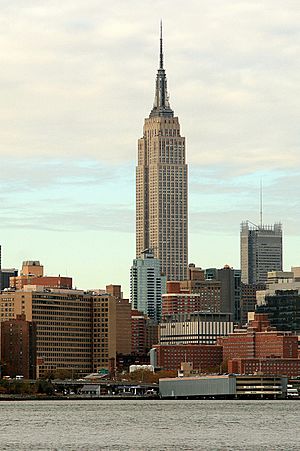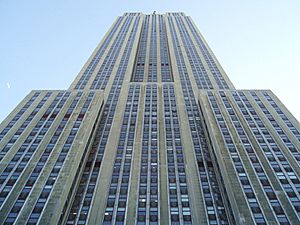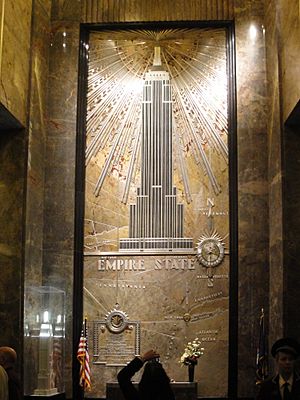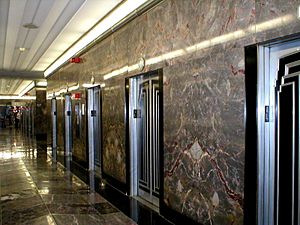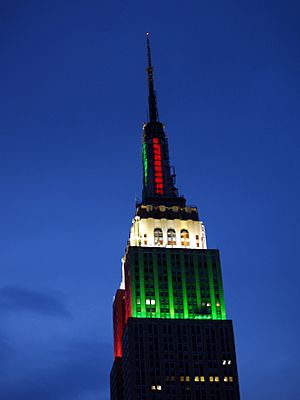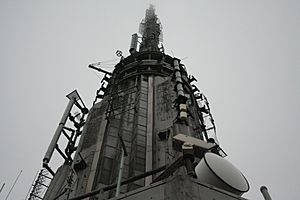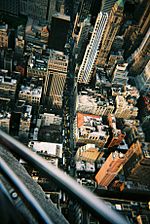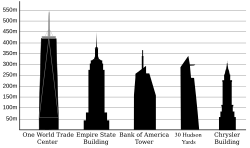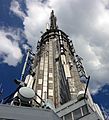Empire State Building facts for kids
Quick facts for kids Empire State Building |
|
|---|---|
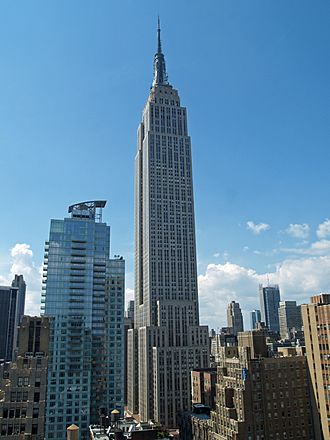 |
|
| General information | |
| Location | New York City |
| Country | United States |
| Construction started | 1930 |
| Completed | 1931 |
| Height | |
| Antenna spire | 381 m (1,250 ft) |
| Technical details | |
| Floor count | 103 |
The Empire State Building is a skyscraper in New York City, United States. It is 381 meters (1,250 feet) tall and has 102 floors, and the height to its pinnacle is 1,454 feet. Named after the popular nickname for New York, The Empire State, it is one of the most famous landmarks in the US.
Designed by the architects named Shreve, Lamb & Harmon Associates, it was built at a time when many people were trying to make the world's tallest building, but the Empire State Building won. It was completed in 410 days and United States President Herbert Hoover turned on the lights on May 1, 1931.
The Empire State Building became the tallest building in New York City and the world, holding this record for forty-one years until the first World Trade Center towers opened in 1973. When these towers were brought down in the September 11, 2001 attacks, the Empire State Building was again the tallest building in New York. It lost this title in April 2013 when the new One World Trade Center surpassed it, which is now the tallest building in the US and the Western Hemisphere.
Contents
History
The site of the Empire State Building was first developed as the John Thompson Farm in the late 18th century. At the time, a stream ran across the site, emptying into Sunfish Pond, located a block away. Beginning in the late 19th century, the block was occupied by the Waldorf-Astoria Hotel, frequented by The Four Hundred, the social elite of New York.
The limestone for the Empire State Building came from the Empire Mill in Sanders, Indiana which is an unincorporated town adjacent to Bloomington, Indiana. The Empire Mill Land office is near State Road 37 and Old State Road 37 just south of Bloomington. The Bloomington, Bedford, and Oolitic area is known locally as the limestone capital of the world.
Design and construction
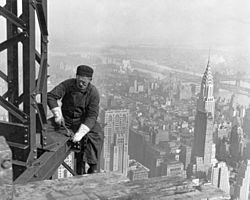
The Empire State Building was designed by William F. Lamb from the architectural firm Shreve, Lamb and Harmon, which produced the building drawings in just two weeks, using its earlier designs for the Reynolds Building in Winston-Salem, North Carolina, and the Carew Tower in Cincinnati, Ohio (designed by the architectural firm W. W. Ahlschlager & Associates) as a basis. Every year the staff of the Empire State Building sends a Father's Day card to the staff at the Reynolds Building in Winston-Salem to pay homage to its role as predecessor to the Empire State Building. The building was designed from the top down. The general contractors were Starrett Brothers and Eken, headed by William A. Starrett, and the project was financed primarily by John J. Raskob and Pierre S. du Pont. The construction company was chaired by Alfred E. Smith, a former Governor of New York and James Farley's General Builders Supply Corporation supplied the building materials. John W. Bowser was project construction superintendent.
Excavation of the site began on January 22, 1930, and construction on the building itself started on March 17—St. Patrick's Day—per Al Smith's influence as Empire State, Inc. president. The project involved 3,400 workers, mostly immigrants from Europe, along with hundreds of Mohawk iron workers, many from the Kahnawake reserve near Montreal. According to official accounts, five workers died during the construction. Governor Smith's grandchildren cut the ribbon on May 1, 1931. Lewis Wickes Hine's photography of the construction provides not only invaluable documentation of the construction, but also a glimpse into common day life of workers in that era.
The construction was part of an intense competition in New York for the title of "world's tallest building". Two other projects fighting for the title, 40 Wall Street and the Chrysler Building, were still under construction when work began on the Empire State Building. Each held the title for less than a year, as the Empire State Building surpassed them upon its completion, on April 11, 1931, 12 days ahead of schedule, just 410 days after construction commenced. The building was officially opened on May 1, 1931 in dramatic fashion, when United States President Herbert Hoover turned on the building's lights with the push of a button from Washington, D.C. Ironically, the first use of tower lights atop the Empire State Building, the following year, was for the purpose of signaling the victory of Franklin D. Roosevelt over Hoover in the presidential election of November 1932.
Opening
The building's opening coincided with the Great Depression in the United States, and as a result much of its office space was initially unrented. The building's vacancy was exacerbated by its poor location on 34th Street, which placed it relatively far from public transportation, as Grand Central Terminal and Penn Station, built decades beforehand, are several blocks away, as is the more recently built Port Authority Bus Terminal. Other more successful skyscrapers, such as the Chrysler Building, did not have this problem. In its first year of operation, the observation deck took in approximately 2 million dollars, as much money as its owners made in rent that year. The lack of renters led New Yorkers to deride the building as the "Empty State Building".
Architecture
Interior
The Empire State Building rises to 1,250 ft (381 m) at the 102nd floor, and including the 203 ft (61.9 m) pinnacle, its full height reaches 1,453 feet 8+9⁄16 inches (443.092 m). The building has 85 stories of commercial and office space representing 2,158,000 sq ft (200,500 m2) of rentable space. It has an indoor and outdoor observation deck on the 86th floor. The remaining 16 stories represent the Art Deco tower, which is capped by a 102nd-floor observatory. Atop the tower is the 203 ft (61.9 m) pinnacle, much of which is covered by broadcast antennas, with a lightning rod at the very top.
The Empire State Building was the first building to have more than 100 floors. It has 6,500 windows and 73 elevators, and there are 1,860 steps from street level to the 102nd floor. It has a total floor area of 2,768,591 sq ft (257,211 m2); the base of the Empire State Building is about 2 acres (8,094 m2). The building houses 1,000 businesses and has its own ZIP code, 10118. As of 2007, approximately 21,000 employees work in the building each day, making the Empire State Building the second-largest single office complex in America, after the Pentagon. Its original 64 elevators are located in a central core; today, the Empire State Building has 73 elevators in all, including service elevators. It takes less than one minute by elevator to get to the 80th floor, which contains a gift shop and an exhibit detailing the building's construction. From there, visitors can take another elevator or climb the stairs to the 86th floor, where an outdoor observation deck is located. The building has 70 mi (113 km) of pipe, 2,500,000 ft (762,000 m) of electrical wire, and about 9,000 faucets. It is heated by low-pressure steam; despite its height, the building only requires between 2 and 3 psi (14 and 21 kPa) of steam pressure for heating. It weighs approximately 365,000 short tons (331,000 t). The exterior of the building is clad in Indiana limestone panels.
The Empire State Building cost $40,948,900 to build (equivalent to $787,975,100 in 2022). Long-term forecasting of the life cycle of the structure was implemented at the design phase to ensure that the building's future intended uses were not restricted by the requirements of previous generations. This is particularly evident in the over-design of the building's electrical system.
The building's art deco design is typical of pre–World War II architecture in New York. The modernistic stainless steel canopies of the entrances on 33rd and 34th Streets lead to two story-high corridors around the elevator core, crossed by stainless steel and glass-enclosed bridges at the second-floor level. The elevator core contains 67 elevators.
The lobby is three stories high and features an aluminum relief of the skyscraper without the antenna, which was not added to the spire until 1952. The north corridor contained eight illuminated panels, created by Roy Sparkia and Renée Nemorov in 1963 in time for the 1964 World's Fair, which depicts the building as the Eighth Wonder of the World, alongside the traditional seven. These panels were eventually moved near a ticketing line for the observation deck.
Until the 1960s, the ceilings in the lobby had a shiny art deco mural inspired by both the sky and the Machine Age, until it was covered with ceiling tiles and fluorescent lighting. Because the original murals, designed by an artist named Leif Neandross, were damaged, reproductions were installed. Over 50 artists and workers used 15,000 square feet of aluminum and 1,300 square feet of 23-carat gold leaf to re-create the mural. Renovations to the lobby alluded to original plans for the building; replacing the clock over the information desk in the Fifth Avenue lobby with an anemometer, as well as installing two chandeliers originally intended to be part of the building when it first opened. In 2000, the building's owners installed a series of paintings by the New York artist Kysa Johnson in the concourse level. In January 2014 the artist filed suit in federal court in New York under the Visual Artists Rights Act, alleging the negligent destruction of the paintings and damage to her reputation as an artist.
Capital improvements were made to the Empire State Building from 1989 to the mid-1990s. These improvements entailed replacing alarm systems, elevators, windows, and air conditioning; making the observation deck compliant with the Americans with Disabilities Act of 1990; and refurbishing the limestone facade. The building's lobbies and common areas received a $550 million renovation in 2009, with improvements including new air conditioning, waterproofing, and renovating the observation deck, and moving the gift shop to the 80th floor. Of this, $120 million was spent in an effort to transform the building into a more energy efficient and eco-friendly structure. For example, the 6,500 windows were remanufactured onsite into superwindows which block heat but pass light. Air conditioning operating costs on hot days were reduced and this saved $17 million of the project's capital cost immediately, partly funding other retrofitting. After receiving a gold Leadership in Energy and Environmental Design (LEED) rating in September 2011, the Empire State Building became the tallest LEED certified building in the United States.
Features
Above the 102nd floor
On the 102nd floor of the Empire State Building there is a door with stairs ascending to the 103rd floor. This was built as a disembarkation floor for airships tethered to the building's spire, and has a circular balcony outside. It is now a hot spot for celebrities, and an access point to reach the spire for maintenance. The room now contains electrical equipment. Above the 103rd floor, there is a set of stairs and a ladder to reach the spire for maintenance work.
The building's Art Deco spire was designed to be a mooring mast and depot for dirigibles. An elevator between the 86th and 102nd floors would carry passengers after they checked in on the 86th floor. The idea proved impractical and dangerous, due to the powerful updrafts caused by the building itself, as well as the lack of mooring lines tying the other end of the craft to the ground. The building's design was expanded to include the mooring mast as part of a competition for the world's tallest building.
A large broadcast tower was added atop the spire in the early 1950s, to support the transmission antennas of several television and FM stations. Until then, NBC had exclusive rights to the site, and – beginning in 1931 – built various, smaller antennas for their television transmissions.
Broadcast stations
New York City is the largest media market in the United States. Since the September 11 attacks, nearly all of the city's commercial broadcast stations (both television and FM radio) have transmitted from the top of the Empire State Building, although a few FM stations are located at the nearby Condé Nast Building. Most New York City AM stations broadcast from sites across the Hudson River in New Jersey or from other surrounding areas.
Broadcasting began at the Empire State Building on December 22, 1931, when RCA began transmitting experimental television broadcasts from a small antenna erected atop the spire. They leased the 85th floor and built a laboratory there, and—in 1934—RCA was joined by Edwin Howard Armstrong in a cooperative venture to test his FM system from the building's antenna. When Armstrong and RCA fell out in 1935 and his FM equipment was removed, the 85th floor became the home of RCA's New York television operations, first as experimental station W2XBS channel 1, which eventually became (on July 1, 1941) commercial station WNBT, channel 1 (now WNBC-TV channel 4). NBC's FM station (WEAF-FM, now WQHT) began transmitting from the antenna in 1940. NBC retained exclusive use of the top of the building until 1950, when the FCC ordered the exclusive deal broken, based on consumer complaints that a common location was necessary for the (now) seven New York-area television stations (five licensed to New York City, NY, one licensed to Newark, NJ, and one licensed to Secaucus, NJ) to transmit from so that receiving antennas would not have to be constantly adjusted. Construction on a giant tower began. Other television broadcasters then joined RCA at the building, on the 83rd, 82nd, and 81st floors, frequently bringing sister FM stations along for the ride. Multiple transmissions of TV and FM began from the new tower in 1951. In 1965, a separate set of FM antennas was constructed ringing the 103rd floor observation area to act as a master antenna. When the World Trade Center was being constructed, it caused serious reception problems for the television stations, most of which then moved to the World Trade Center as soon as it was completed. This made it possible to renovate the antenna structure and the transmitter facilities for the benefit of the FM stations remaining there, which were soon joined by other FMs and UHF TVs moving in from elsewhere in the metropolitan area. The destruction of the World Trade Center necessitated a great deal of shuffling of antennas and transmitter rooms to accommodate the stations moving back uptown.
Observation decks
The Empire State Building has one of the most popular outdoor observatories in the world, having been visited by over 110 million people. The 86th-floor observation deck offers impressive 360-degree views of the city. There is a second observation deck on the 102nd floor that is open to the public. It was closed in 1999, but reopened in November 2005. It is completely enclosed and much smaller than the first one; it may be closed on high-traffic days. Tourists may pay to visit the observation deck on the 86th floor and an additional amount for the 102nd floor. The lines to enter the observation decks, according to Concierge.com, are "as legendary as the building itself:" there are five of them: the sidewalk line, the lobby elevator line, the ticket purchase line, the second elevator line, and the line to get off the elevator and onto the observation deck. For an extra fee tourists can skip to the front of the line. The Empire State Building makes more money from tickets sales for its observation decks than it does from renting office space.
The skyscraper's observation deck plays host to several cinematic, television, and literary classics including, An Affair To Remember, On the Town, Love Affair and Sleepless in Seattle. In the Latin American literary classic, Giannina Braschi's Empire of Dreams the observation deck is the site of a pastoral revolution; shepherds take over the City of New York. The deck was also the site of a publicity-stunt Martian invasion in an episode of I Love Lucy ("Lucy Is Envious", season 3, episode 25).
New York Skyride
The Empire State Building also has a motion simulator attraction located on the 2nd floor. Opened in 1994 as a complement to the observation deck, the New York Sky ride (or NY Sky ride) is a simulated aerial tour over the city. The cinematic presentation lasts approximately 25 minutes. As of May 2013, tickets are Adults $57, Children $42, Seniors $49.
Since its opening, the ride has gone through two incarnations. The original version, which ran from 1994 until around 2002, featured James Doohan, Star Trek's Scotty, as the airplane's pilot, who humorously tried to keep the flight under control during a storm, with the tour taking an unexpected route through the subway, Coney Island, and FAO Schwartz, among other places. After the September 11 attacks in 2001, however, the ride was closed, and an updated version debuted in mid-2002 with actor Kevin Bacon as the pilot. The new version of the narration attempted to make the attraction more educational, and included some minor post-9/11 patriotic undertones with retrospective footage of the World Trade Center. The new flight also goes haywire, but this segment is much shorter than in the original.
Lights
In 1964, floodlights were added to illuminate the top of the building at night. Since 1976 the spire has been lit in colors chosen to match seasonal and other events, such as St. Patrick's Day, Christmas, Independence Day and Bastille Day. After the eightieth birthday and subsequent death of Frank Sinatra, for example, the building was bathed in blue light to represent the singer's nickname "Ol' Blue Eyes". After the death of actress Fay Wray (King Kong) in late 2004, the building stood in complete darkness for 15 minutes.
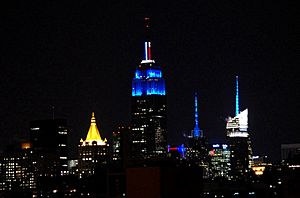
The floodlights bathed the building in red, white, and blue for several months after the destruction of the World Trade Center, then reverted to the standard schedule. On June 4, 2002, the Empire State Building donned purple and gold (the royal colors of Elizabeth II), in thanks for the United Kingdom playing the Star Spangled Banner during the Changing of the Guard at Buckingham Palace on September 12, 2001 (a show of support after the September 11 attacks). This would also be shown after the Westminster Dog Show. Traditionally, in addition to the standard schedule, the building will be lit in the colors of New York's sports teams on the nights they have home games (orange, blue and white for the New York Knicks, red, white and blue for the New York Rangers, and so on). The first weekend in June finds the building bathed in green light for the Belmont Stakes held in nearby Belmont Park. The building is illuminated in tennis-ball yellow during the US Open tennis tournament in late August and early September. It was twice lit in scarlet to support nearby Rutgers University: once for a football game against the University of Louisville on November 9, 2006, and again on April 3, 2007 when the women's basketball team played in the national championship game. On January 13, 2012, the building was lit in red, orange, and yellow to honor the 60th anniversary of NBC's The Today Show making it the first time the building was illuminated to honor a television program. From June 1 to 3, 2012, the building was lit in blue and white, the colors of the Israeli flag, in honor of the 49th annual Celebrate Israel Parade.
During 2012, the building's metal halide lamps and floodlights were replaced with LED fixtures, increasing the available colors from nine to over 16 million. The computer-controlled system allows the building to be illuminated in ways that were unable to be done previously with plastic gels.
Height records and comparisons
The Empire State Building remained the tallest man-made structure in the world for 23 years before it was surpassed by the Griffin Television Tower Oklahoma (KWTV Mast) in 1954. It was also the tallest free-standing structure in the world for 36 years before it was surpassed by the Ostankino Tower in 1967.
The longest world record held by the Empire State Building was for the tallest skyscraper (to structural height), which it held for 42 years until it was surpassed by the North Tower of the World Trade Center in 1972. An early-1970s proposal to dismantle the spire and replace it with an additional 11 floors, which would have brought the building's height to 1,494 feet (455 m) and made it once again the world's tallest at the time, was considered but ultimately rejected.
On clear days, the building can be seen from much of the New York Metropolitan Area, and as far away as New Haven, Connecticut and Morristown, New Jersey.
Neighboring Midtown Manhattan landmarks
The Empire State Building anchors an area of Midtown which features other major Manhattan landmarks as well, including Macy's Herald Square, Koreatown, Penn Station, Madison Square Garden, and the Flower District. Collectively, these sites contribute to a significant volume of commuter and tourist pedestrian traffic traversing the southern portion of Midtown Manhattan.
Related pages
Images for kids
-
Lights representing the Democratic and Republican parties just prior to the 2012 election
-
The Empire State Building is bathed annually in rainbow-colored lighting during the Pride Month of June, evoking the international LGBT icon, as seen in this 2015 image.
-
Photograph of a cable worker taken by Lewis Hine
-
The World Trade Center's Twin Towers surpassed the Empire State Building in height by 1970.
-
Since 2009, the Empire State Building has been lit blue and white annually for commencement at Columbia University
-
The current One World Trade Center (seen in the distance) surpassed the Empire State Building's height on April 30, 2012
-
Wreckage from the 1945 Empire State Building B-25 crash
See also
 In Spanish: Empire State Building para niños
In Spanish: Empire State Building para niños


